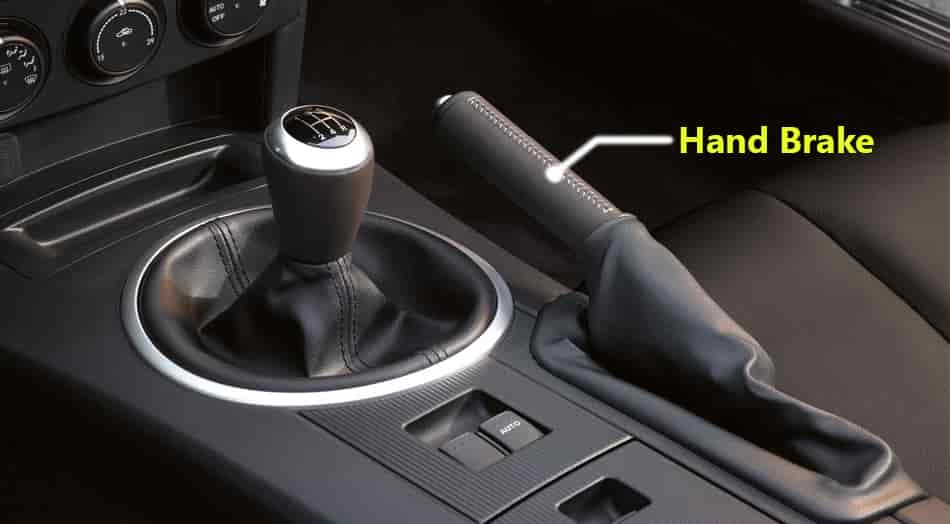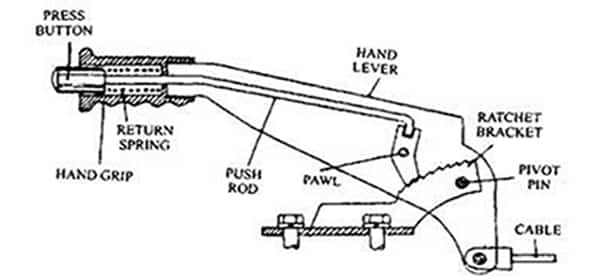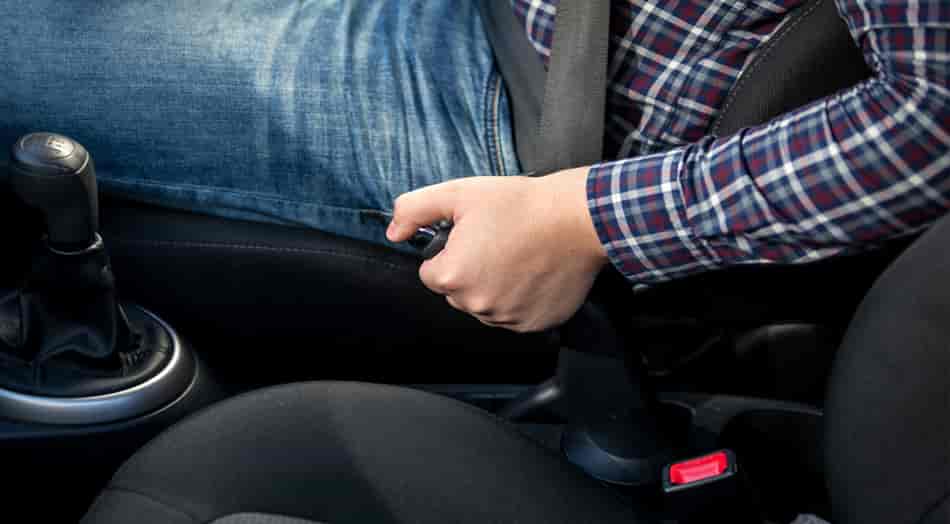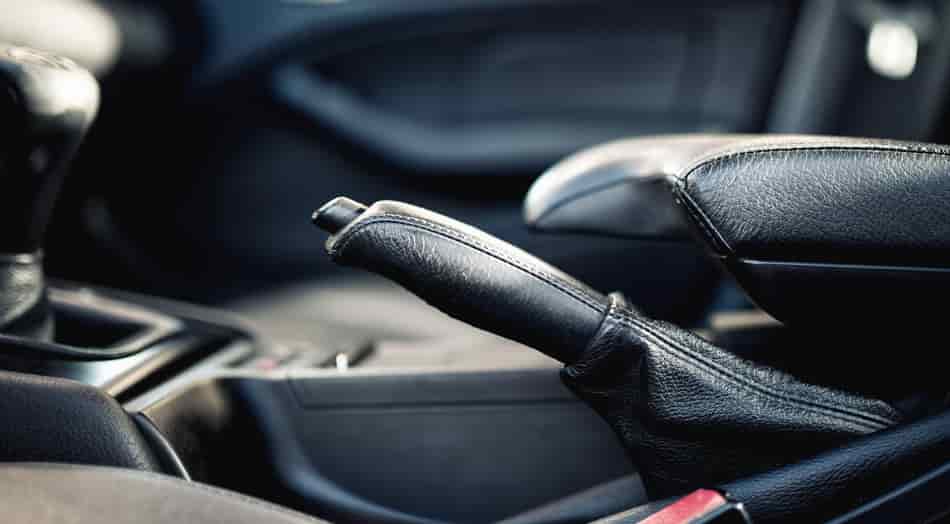The parking brake or handbrake in a car or vehicle, often taken for granted in our everyday driving experiences, is a crucial component of a vehicle’s braking system. While it might seem like a simple lever or button, the handbrake plays a significant role in ensuring safety, stability, and control during various driving scenarios.
From its humble origins as a simple lever to its integration into advanced electronic systems, the handbrake has come a long way. It is not just a tool for parking; it serves multiple purposes, from emergency stops to enhancing stability in certain driving conditions. Understanding how handbrakes work and how to maintain them is vital for every driver.
What is Parking Brake or Hand Brake in Car or Vehicle?
Handbrakes are one of the essential components of an automobile’s braking system, also known as parking brakes or emergency brakes. It serves multiple functions beyond just parking, contributing to the safety and stability of a vehicle.

Definition of Handbrakes
A handbrake, often referred to as a parking brake or emergency brake, is a mechanical or electronic device installed in a vehicle to assist in parking and emergency stopping. It operates independently of the primary foot-operated brake system, typically using a hand-operated lever, button, or switch.
The handbrake’s primary purpose is to securely hold a stationary vehicle in place when parked on an incline or flat surface, preventing it from rolling. Additionally, it can serve as an emergency backup brake in case of a primary brake system failure. In some advanced vehicles, handbrakes are electronically integrated with other safety and stability control systems to enhance overall vehicle performance.
History of Handbrakes
The history of handbrakes dates back to the early days of automobiles in the late 19th century. They began as simple hand-operated mechanisms and evolved into more advanced mechanical and electronic systems in modern vehicles, enhancing safety and convenience. As cars developed, handbrakes became standard features, aiding in parking and safety. Today, electronic handbrakes are integrated into advanced vehicle systems for enhanced functionality.
What are the Parts of a Handbrake in a Car?
A typical handbrake consists of three main parts:

- Lever or Button: The user interface for engaging and disengaging the handbrake, often in the form of a lever or button located in the vehicle’s cabin.
- Cable or Mechanism: A cable or mechanical linkage that connects the lever or button to the handbrake mechanism at the rear wheels, allowing the driver to apply force to engage the brake.
- Brake Mechanism: Located at the rear wheels, this component includes a set of brake shoes or pads that are pressed against the brake drum or disc when the handbrake is engaged, effectively immobilizing the vehicle.
- Handbrake Lever Lock: Many handbrake levers have a locking mechanism that keeps the handbrake engaged without the need to hold the lever in place continuously. This lock ensures the vehicle remains stationary when parked.
- Handbrake Warning Light: In modern vehicles, a warning light on the dashboard indicates when the handbrake is engaged. This serves as a reminder to the driver and helps prevent driving with the handbrake on.
- Electronic Control Unit (ECU): In vehicles with electronic handbrakes, an ECU is responsible for controlling the operation of the handbrake. It can integrate with other safety and stability control systems, allowing for advanced features such as hill-start assist and auto-release when accelerating.
How Does a Handbrake PLC Work?
The handbrake, often overlooked but undeniably essential, plays a pivotal role in ensuring vehicle safety and control. Understanding how this component works is crucial for every driver.
- Activation: When the driver engages the handbrake lever or button, it triggers a mechanism that applies force to the rear brakes.
- Independent Function: The handbrake works independently of the foot-operated brake system, allowing it to be used for parking and emergency situations.
- Cable or Linkage: A cable or mechanical linkage transmits the force from the handbrake lever to the rear brakes.
- Brake Engagement: The rear brakes typically drum brakes or brake pads on a disc, are pressed against the brake drum or disc, creating friction and preventing the vehicle from moving.
- Parking: The handbrake is commonly used for parking on inclines or when stationary for an extended period, providing stability and preventing the vehicle from rolling.
- Emergency Brake: In case of a primary brake system failure, the handbrake can serve as an emergency backup brake, helping to stop the vehicle safely.
- Release: To disengage the handbrake, the driver releases the lever or button, allowing the rear brakes to release and the vehicle to move freely again.
Reasons for Hard Brakes
Hard brakes can be triggered by various factors, including:

- Traffic Conditions: Congestion, sudden lane changes, and unexpected road hazards can force drivers to slam on the brakes.
- Distracted Driving: Texting, talking on the phone, eating, or other distractions can lead to delayed reactions, resulting in hard brakes when the driver finally realizes the need to stop.
- Tailgating: Following the vehicle in front too closely can leave little room for reaction time, leading to hard brakes when the driver ahead stops suddenly.
- Inexperienced Drivers: Novice drivers may struggle to judge the right amount of pressure to apply to the brake pedal, often resulting in hard brakes.
- Mechanical Issues: Problems with the vehicle’s brakes or suspension system can lead to unexpected hard brakes.
- Emergency Situations: In some cases, hard braking is necessary to avoid a collision or navigate a sudden, dangerous situation.
Impact of Hard Brakes on Vehicle Safety
- Tire Wear and Tear: Hard brakes can cause excessive wear and tear on tires, reducing their lifespan. The abrupt stop can cause flat spots on the tires and uneven wear patterns.
- Brake Wear: The brake pads and rotors also suffer from hard braking. Frequent hard braking can lead to premature wear and the need for costly brake replacements.
- Suspension and Shock Absorbers: The sudden deceleration can put stress on the suspension and shock absorbers, potentially leading to damage and compromised ride quality.
- Reduced Fuel Efficiency: Hard braking and rapid acceleration lead to decreased fuel efficiency, increasing the overall cost of driving.
- Transmission Strain: Hard braking can also put a strain on the vehicle’s transmission, potentially leading to transmission issues over time.
Impact of Hard Brakes on Road Safety
- Rear-End Collisions: One of the most common consequences of hard brakes is rear-end collisions. When a driver abruptly stops, the following vehicle may not have enough time to react and stop in time, leading to a collision.
- Traffic Congestion: Frequent hard braking in heavy traffic can create a ripple effect, causing traffic jams and delays for other drivers.
- Reduced Reaction Time: Hard brakes reduce the reaction time of drivers behind the braking vehicle. This can be especially dangerous on highways or roads with high-speed limits.
- Aggressive Driving Behavior: Habitual use of hard brakes can contribute to aggressive driving behavior, further increasing the risk of accidents and road rage incidents.
- Environmental Impact: Excessive hard braking and acceleration increase fuel consumption and emissions, contributing to air pollution and environmental damage.
| Vehicle Safety Consequences | Road Safety Impacts |
| Accelerated Tire Wear | Elevated Risk of Rear-End Collisions |
| Heightened Brake Wear | Traffic Bottlenecks |
| Strain on Suspension and Shocks | Diminished Reaction Time |
| Reduced Fuel Efficiency | Fosters Aggressive Driving Behavior |
| Transmission Stress | Environmental Harm |
Types of Handbrakes
Handbrakes, also known as parking brakes or emergency brakes, play a critical role in ensuring vehicle safety and preventing unintended movement when parked. There are several types of handbrakes commonly used in vehicles today, each with its own design and mechanism. Here is a brief overview of the most common types of handbrakes:

Lever or Hand Lever Handbrake
This is the traditional type of handbrake found in older vehicles and some modern ones. It consists of a lever located between the driver and passenger seats. When the driver pulls the lever upwards, it engages the handbrake, applying force to the rear brake shoes or pads. To release it, the driver typically pushes a button on the lever while simultaneously pressing down or lifting it.
Foot Pedal Handbrake
Some vehicles, especially those with automatic transmissions, have a foot pedal handbrake. Instead of a lever, this type of handbrake is operated using a foot pedal located on the floor of the vehicle. Pressing the pedal activates the handbrake, and releasing it disengages the brake.
Electronic Handbrake (e-Brake)
Many modern vehicles are equipped with electronic handbrakes, which are often button or switch-operated. When engaged, an electronic handbrake applies the brakes electronically, and there is no physical connection to the brake components. It is typically more compact and easier to use, often offering additional features like automatic release when driving off.
Center Console Handbrake
This type of handbrake is integrated into the center console of the vehicle. It can be either a lever-style or electronic handbrake. Center console handbrakes are common in many newer vehicles as they free up space between the driver and front passenger seats.
Drum Brake Handbrake
Some older vehicles and trucks may have a handbrake system that specifically operates the rear drum brakes. It functions similarly to a traditional lever handbrake but is designed to engage and disengage the drum brakes.
Cable-Operated Handbrake
In some cases, handbrakes use cables to transmit the force from the lever or pedal to the rear brake components. This design is often used in conjunction with lever or pedal handbrakes and allows for remote operation of the parking brake.
Multi-Function Handbrake
Some modern vehicles incorporate the handbrake into a multi-function lever or switch, combining it with other controls like the gear shifter or electronic stability control. These systems provide convenience and space-saving benefits.
The type of handbrake used in a vehicle depends on its make, model, and design. While the traditional lever handbrake remains popular, electronic and foot pedal handbrakes are becoming more prevalent due to their ease of use and modern features.
Regardless of the type, maintaining the handbrake’s functionality is crucial for vehicle safety, as it serves as a backup in case of primary braking system failure and prevents unintended movement when parked.
Minimizing Hard Brakes
Now that we understand the significance of hard brakes, it is important to explore ways to minimize their occurrence and promote road safety:
Make sure you maintain a safe following distance
Stay a safe distance from the vehicle ahead of you at all times. The general rule of thumb is to stay at least three seconds behind the vehicle in normal conditions and increase this distance in adverse weather or heavy traffic.
Anticipate Traffic Flow
Try to anticipate changes in traffic flow by scanning the road ahead and being aware of brake lights and turn signals from other vehicles. Look further down the road to anticipate potential obstacles.
Avoid Distractions
Stay focused on driving and avoid distractions like texting, making phone calls, eating, or fiddling with the radio. Use hands-free devices if you need to communicate while driving.
Smooth Braking Technique
Practice smooth and gradual braking rather than slamming on the brakes. Apply pressure to the brake pedal progressively, allowing for a more controlled stop. If you drive a manual transmission vehicle, downshifting can also help in deceleration without heavy braking.
Regular Vehicle Maintenance
Keep your vehicle in good working condition by following the recommended maintenance schedule. This includes checking the brakes, tires, and suspension components. Properly maintained brakes are more effective at stopping your vehicle smoothly.
Defensive Driving
Practice defensive driving techniques, which involve being prepared for the unexpected actions of other drivers and adjusting your driving accordingly. This includes staying aware of your surroundings, anticipating potential hazards, and leaving yourself an escape route in case of emergencies.
Emergency Braking Techniques
In the event of an emergency, it’s important to know how to perform emergency braking safely. This involves firmly but progressively applying the brakes while maintaining control of the steering wheel. Avoid locking up the brakes, as this can result in loss of control.
Advantages of Handbrakes
- Parking Safety: Handbrakes provide an extra layer of security when parking a vehicle. They prevent the vehicle from rolling or moving unintentionally, especially on inclined surfaces.
- Emergency Use: Handbrakes can be used in emergency situations when the primary braking system fails. They serve as a backup mechanism to slow down or stop the vehicle.
- Hill Starts: Handbrakes assist in hill starts. By engaging the handbrake while stopped on an incline, the driver can release it gradually while applying the gas pedal, preventing the vehicle from rolling backward.
- Maintenance Aid: When engaged, handbrakes can help maintain the brakes’ adjustment and keep them in better working condition over time.
- Manual Transmission Control: In manual transmission vehicles, handbrakes allow for smooth gear changes and help prevent wear on the clutch when starting on an incline.
Disadvantages of Handbrakes:
- Limited Holding Power: Handbrakes typically have less holding power than the primary brake system. They are designed for parking and emergency use rather than for rapid deceleration.
- Complexity: In some vehicles, handbrakes can be complex to use effectively, especially for inexperienced drivers. This can lead to improper engagement or disengagement.
- Engagement and Disengagement Time: Engaging and disengaging a handbrake can take time, which can be inconvenient in situations where quick action is required, such as sudden stops in traffic.
- Maintenance Requirements: Handbrakes require periodic maintenance to ensure they function correctly. Cables, linkage, and brake components may need adjustment or replacement over time.
- Variability: Different types of handbrakes (lever, pedal, electronic, etc.) may have varying levels of user-friendliness and reliability, depending on the vehicle’s make and model.
| Handbrake Advantages | Handbrake Disadvantages |
| Enhanced Parking Safety | Limited Holding Capacity |
| Emergency Stopping Capability | Potential Complexity |
| Assistance with Hill Starts | Engagement and Disengagement Time |
| Maintenance Aid | Maintenance Obligations |
| Control in Manual Transmissions | Variability |
The Future of Handbrakes
The automotive industry is continually evolving, and as vehicles become more advanced, the role and design of handbrakes are also changing. Here are some potential developments in the future of handbrakes:
Electronic Parking Brakes (EPB)
Electronic handbrakes, which are becoming more common, offer compact design and automatic release features. They may become the standard in modern vehicles due to their convenience and integration with vehicle electronics.
Advanced Driver-Assistance Systems (ADAS)
Handbrakes could be integrated into ADAS to provide intelligent parking assistance, automatic hill-hold functions, and enhanced safety features like automated parking.
Electric and Autonomous Vehicles
The integration of handbrakes in electric and autonomous vehicles may evolve to cater to the unique characteristics of these vehicles. For example, self-parking and autonomous driving systems may rely on handbrakes for precise control during parking maneuvers.
Enhanced User Interface
Future handbrake systems may incorporate intuitive user interfaces, such as touch screens or voice commands, making them easier to use for all drivers.
Increased Reliability and Durability
Ongoing research and development will likely lead to more reliable and durable handbrake systems that require less maintenance over time.
Regenerative Braking Integration
Electric and hybrid vehicles with regenerative braking systems could integrate handbrakes in ways that optimize energy recovery and improve overall efficiency.
Safety Integration
Handbrakes may be further integrated into vehicle safety systems, offering features like automatic handbrake engagement in case of detected collision risks or rollover situations.
| Upcoming Developments | Description |
| Electronic Parking Systems (EPB) | Growing adoption due to compact design and automation |
| Integration into ADAS | Implementation into safety and parking assistance systems |
| Tailoring to Electric and Autonomous Vehicles | Adaptation for electric and autonomous vehicle characteristics |
| Enhanced User Interfaces | Inclusion of user-friendly interfaces for simplified operation |
| Heightened Reliability and Durability | Ongoing research for more dependable and long-lasting handbrakes |
| Integration with Regenerative Braking | Combining with energy-efficient regenerative braking systems |
| Safety System Integration | Further incorporation into vehicle safety mechanisms |
Changing a Broken or Faulty Handbrake Cable
- Gather Tools: You will need a car jack, jack stands, pliers, wrenches, and a replacement handbrake cable.
- Safety First: Ensure your vehicle is parked on a flat, level surface and the engine is turned off. Engage the primary brakes, and use wheel chocks to prevent rolling.
- Raise the Vehicle: Use a car jack to lift the rear of your vehicle and secure it with jack stands for safety.
- Locate the Handbrake Cable: Locate the handbrake cable under the vehicle. It is typically found near the rear wheels and runs from the handbrake lever to the brake components.
- Remove the Old Cable: Use pliers and wrenches to disconnect the old cable from both the handbrake lever inside the car and the rear brake assembly.
- Install the New Cable: Attach the new handbrake cable in the reverse order, connecting it first to the handbrake lever and then to the rear brake assembly. Ensure it’s properly routed and secured.
- Adjust the Cable: Adjust the tension of the handbrake cable to achieve the right amount of resistance when pulling the lever. Consult your vehicle’s manual for specific instructions on cable adjustment.
- Test the Handbrake: With the car still safely elevated, test the handbrake to ensure it engages and disengages correctly.
- Lower the Vehicle: Once you’re satisfied with the handbrake’s performance, carefully lower the vehicle from the jack stands.
- Double-Check: Double-check all connections and cable routing to ensure everything is secure.
Fixing Other Handbrake Issues
Stuck Handbrake Lever
If the handbrake lever is stuck in the “up” position and would not disengage, it may be due to a faulty release mechanism or cable. Consult your vehicle’s manual or seek professional assistance for diagnosis and repair.
Spongy or Ineffective Handbrake
If your handbrake feels spongy or does not hold the vehicle properly, it might need an adjustment. This often involves tightening the cable or adjusting the brake shoes or pads in the rear brakes. Refer to your vehicle’s manual for specific instructions on adjusting the handbrake.
Noisy Handbrake
If your handbrake makes unusual noises when engaged or disengaged, it could be due to worn brake components or loose parts. Inspect the handbrake assembly and rear brakes for any issues and replace or tighten components as needed.
Professional Help
If you are unsure about fixing a handbrake issue or if the problem persists after attempting repairs, it is advisable to consult a professional mechanic or a certified service center for a thorough inspection and proper repair.
People May Ask: FAQs
What is a handbrake, and what is its primary purpose in a vehicle?
Handbrakes are a secondary braking system used in vehicles. They are also called parking brakes or emergency brakes. Its primary purpose is to secure the vehicle in a parked position, preventing it from moving unintentionally. It is especially crucial on inclines and in emergency situations when the primary brakes fail.
Why is it essential to use a handbrake when parking a vehicle?
Using a handbrake when parking is essential because it provides an extra layer of safety. Especially on incline surfaces, it keeps the vehicle from rolling. Without it, the vehicle could move, leading to accidents or damage.
What are the common signs of a faulty handbrake, and how can I identify them?
Common signs of a faulty handbrake include a loose or excessively tight handbrake lever, unusual noises when engaging or disengaging, or a handbrake that doesn’t hold the vehicle in place. If you notice any of these signs, it is important to have your handbrake inspected and repaired by a qualified mechanic.
How often should I check and maintain my handbrake?
Regular maintenance of your handbrake is essential for safety. It is a good practice to have your handbrake inspected during routine vehicle maintenance or when you notice any signs of issues. Additionally, lubricating the handbrake cable and keeping it free from debris can help ensure its proper function.
What should I do if my handbrake fails to engage or disengage properly?
If your handbrake fails to engage or disengage correctly, do not continue driving. Contact a qualified mechanic or a professional service center to inspect and repair the handbrake. It is crucial to address any issues promptly to maintain vehicle safety.
Conclusion
Hard brake poses significant risks to road safety, affecting both vehicles and drivers. Reducing their occurrence is crucial for responsible driving. Maintain a safe distance, stay focused, and brake smoothly to enhance road safety. Responsible driving not only reduces hard brakes but also contributes to environmental conservation and a better driving experience.

